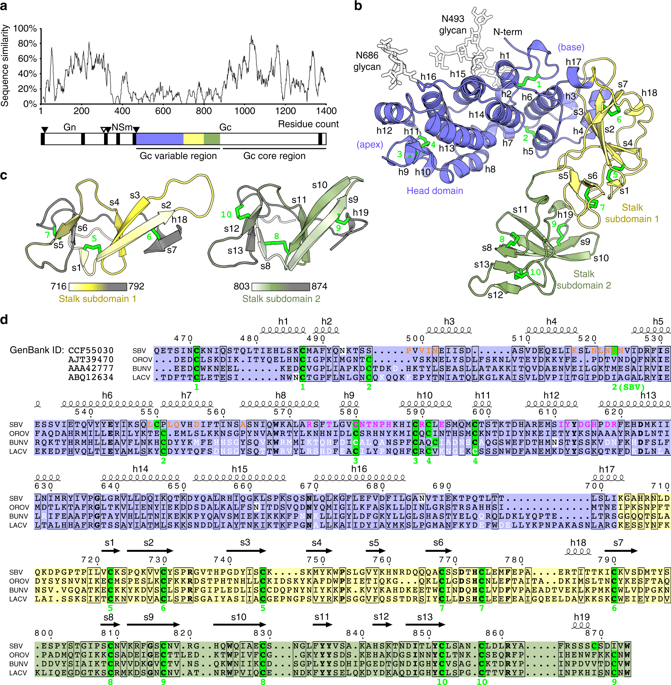当前位置:
X-MOL 学术
›
Nat. Commun.
›
论文详情
Our official English website, www.x-mol.net, welcomes your
feedback! (Note: you will need to create a separate account there.)
Orthobunyavirus spike architecture and recognition by neutralizing antibodies.
Nature Communications ( IF 14.7 ) Pub Date : 2019-02-20 , DOI: 10.1038/s41467-019-08832-8 Jan Hellert 1 , Andrea Aebischer 2 , Kerstin Wernike 2 , Ahmed Haouz 3 , Emiliana Brocchi 4 , Sven Reiche 5 , Pablo Guardado-Calvo 1 , Martin Beer 2 , Félix A Rey 1
Nature Communications ( IF 14.7 ) Pub Date : 2019-02-20 , DOI: 10.1038/s41467-019-08832-8 Jan Hellert 1 , Andrea Aebischer 2 , Kerstin Wernike 2 , Ahmed Haouz 3 , Emiliana Brocchi 4 , Sven Reiche 5 , Pablo Guardado-Calvo 1 , Martin Beer 2 , Félix A Rey 1
Affiliation

|
Orthobunyaviruses (OBVs) form a distinct genus of arthropod-borne bunyaviruses that can cause severe disease upon zoonotic transmission to humans. Antigenic drift or genome segment re-assortment have in the past resulted in new pathogenic OBVs, making them potential candidates for causing emerging zoonoses in the future. Low-resolution electron cryo-tomography studies have shown that OBV particles feature prominent trimeric spikes, but their molecular organization remained unknown. Here we report X-ray crystallography studies of four different OBVs showing that the spikes are formed by an N-terminal extension of the fusion glycoprotein Gc. Using Schmallenberg virus, a recently emerged OBV, we also show that the projecting spike is the major target of the neutralizing antibody response, and provide X-ray structures in complex with two protecting antibodies. We further show that immunization of mice with the spike domains elicits virtually sterilizing immunity, providing fundamental knowledge essential in the preparation for potential newly emerging OBV zoonoses.
中文翻译:

通过中和抗体,正杯病毒增强结构和识别能力。
支原体病毒(OBV)形成了节肢动物传播的布尼亚病毒的独特属,它们在人畜共患病传播给人类时会引起严重的疾病。过去,抗原漂移或基因组片段的重新分类产生了新的致病性OBV,使其成为将来引起新的人畜共患病的潜在候选者。低分辨率电子冷冻断层扫描研究表明,OBV颗粒具有突出的三聚体尖峰,但其分子组织仍然未知。在这里,我们报告了四个不同的OBV的X射线晶体学研究,结果表明,尖峰是由融合糖蛋白Gc的N端延伸形成的。使用Schmallenberg病毒(一种最近出现的OBV),我们还显示出突出的突波是中和抗体反应的主要目标,并提供与两种保护性抗体复合的X射线结构。我们进一步表明,对带有尖峰域的小鼠进行免疫实际上会激发杀菌力,从而为潜在的新兴OBV人畜共患病的制备提供必要的基础知识。
更新日期:2019-02-20
中文翻译:

通过中和抗体,正杯病毒增强结构和识别能力。
支原体病毒(OBV)形成了节肢动物传播的布尼亚病毒的独特属,它们在人畜共患病传播给人类时会引起严重的疾病。过去,抗原漂移或基因组片段的重新分类产生了新的致病性OBV,使其成为将来引起新的人畜共患病的潜在候选者。低分辨率电子冷冻断层扫描研究表明,OBV颗粒具有突出的三聚体尖峰,但其分子组织仍然未知。在这里,我们报告了四个不同的OBV的X射线晶体学研究,结果表明,尖峰是由融合糖蛋白Gc的N端延伸形成的。使用Schmallenberg病毒(一种最近出现的OBV),我们还显示出突出的突波是中和抗体反应的主要目标,并提供与两种保护性抗体复合的X射线结构。我们进一步表明,对带有尖峰域的小鼠进行免疫实际上会激发杀菌力,从而为潜在的新兴OBV人畜共患病的制备提供必要的基础知识。


















































 京公网安备 11010802027423号
京公网安备 11010802027423号